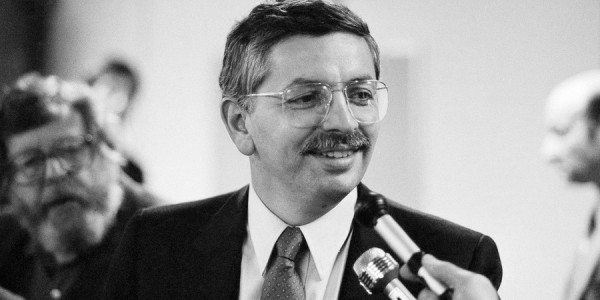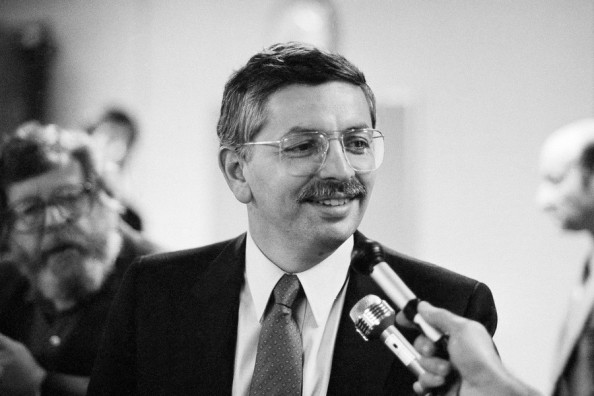The NBA has certainly changed, mostly for the better, during David Stern’s 28 years at the helm, as commissioner of the league. It’ll be an even 30 once he retires, and despite all that he’s done (along with getting the right kind of start to promote), there’s a feeling that his last few years at the job hurt his early days achievements.
Why? Because it seemed like Stern made more and more decision that went against the players; sometimes for no reason at all, just to prove a point and to show who’s boss. Maybe in a few years it’ll be looked on a bit differently, but there’s no doubt that when Stern leaves the position, he’ll be very far away from the height of his popularity at the position, which seems to be light years ago.
February 1, 1984 – David Stern becomes the commissioner of the NBA. That same season the league signs a 2-year, $20 million broadcast deal with TBS for cable broadcasting rights. The San Diego Clippers move to Los Angeles.
1985 – The lottery system is implemented. Instead of a coin toss between the two worst teams in the league, the non-playoff teams (seven at the time) have an envelope in a hopper and have them blindly drawn to determine the selection order of the draft. Kansas City Kings move to Sacramento.
1986 – NBA signs a 2-year, $25 million TV deal with TBS for cable broadcasting rights and a 4-year, $173 million deal with CBS for network broadcasting rights.
1988 – The league is expanded by the induction of the Charlotte Hornets and the Miami Heat. The league now has 25 teams. The NBA signs a 2-year, $50 million deal with TBS and TNT for cable broadcasting rights. The league also moves from two officials to three during games.
1989 – More expansion, as the Orlando Magic and the Minnesota Timberwolves join the NBA, making it a 27-team league. Stern changes his mind about NBA players going to the Olympics (following the failure in the 1988 games), helping form USA basketball which led to the first dream team in 1992.
1990 – More big TV money comes in. NBA signs a 4-year, $275 million deal with TNT to broadcast games on cable and a 4-year, $601 million deal with NBC to broadcast games on network TV.
1993 – The beginning of Stern’s crackdown on players’ behavior, on the court and off of it. New rule giving automatic suspensions for any players throwing a punch in a game, connecting on a punch during a game, and leaving the bench area during a fight. Jordan retires after the 1993 NBA finals.
1994 – The finals between the Rockets and the Knicks see a dip in the ratings, from 17.9 in 1993 to 12.4 in 1994, despite having the biggest market in the NBA involved. New broadcast deal: NBA signs a 4-year, $397 million deal with TNT/TBS for cable broadcasting rights and 4-year, $892 million deal with NBC for network broadcasting rights.
1995 – The NBA’s first lockout, which doesn’t effect the season (Between July and September). The league also expands to 29 teams, with two Canadian teams, the Toronto Raptors and the Vancouver Grizzlies, joining the NBA.
1997 – The NBA helps form the WNBA. Not a lot of people cared. Stern suspends P.J. Brown, Larry Johnson, John Starks, Charlie Ward, Patrick Ewing and Allan Houston for a playoff altercation between the Knicks and Heat.
1998 – More money, and finally more problems. The NBA signs a new TV contract; 4-year, $840 million contract with TNT/TBS for cable television rights and 4-year, $1.616 billion contract with NBC for network rights. A lockout begins on July 1st, carrying into 1999, forcing the NBA to have a shortened 50 game season.
1999 – Big changes in defense, with any type of defense allowed on the strong side of the ball (semi-zone) and the league eliminates hand-checking altogether and forearm checking anywhere but below the free throw line extended.
2001 – No such thing anymore as illegal defense, while a defensive three-second rule is installed. The Vancouver Grizzlies leave Canada and set up shop in Memphis.
2002 – New TV deal; 6-year, $2.2 billion deal with TNT for cable broadcasting rights and a 6-year, 2.4 billion with ABC/ESPN on network broadcasting rights. The NBA allows limited instant replay during games, while the Charlotte Hornets leave to New Orleans.
2004 – Charlotte get a team again, the Bobcats. Hand-checking is completely abolished. The Pistons – Pacers brawl happens; Nine players are suspended, Ron Artest gets worse of the rulings by missing 86 games (including 13 playoffs games).
2005 – The NBA institutes the hated dress code for players.
2006 – Age limit, pretty much ending the prep-to-pro era. Incoming players to be one year removed from their high school, along with having to be 19 years of age in the same calendar year before entering the NBA draft. International players must turn 19 during the calendar year of that draft. The NBA tries to introduce a new ball, but returns to the old one in three months after too many complaints from the players.
2007 – Amare Stoudemire and Boris Diaw get suspended just for leaving the bench during a playoff series between the Suns and the Spurs. Stern allows Bennett and his ownership group to purchase the Seattle Supersonics and move them to Oklahoma City.
2008 – New TV deal: eight years and $7.44 billion.
2011 – Another big lockout, which goes on from July 1 to December 8, 2011. It forced the league to shorten each team’s schedule to 66 games.


2 responses to “David Stern – A Timeline of an NBA Commissioner Career”
[…] States With Megamillion Lottery – Win These days Regardless of Which State Your In!Your Questions About Win Lotto OnlineCasinos In IndianaYour Questions About Lotto 649Our Free Lotto Strategy : Blog – My Free Lottery PoolMobile Coffee Bar – How to make the perfect espresso.A list of early entrants for the 2012 NBA DraftDavid Stern – A Timeline of an NBA Commissioner Career […]
Google
Every when in a while we opt for blogs that we study. Listed below are the most recent web pages that we pick.